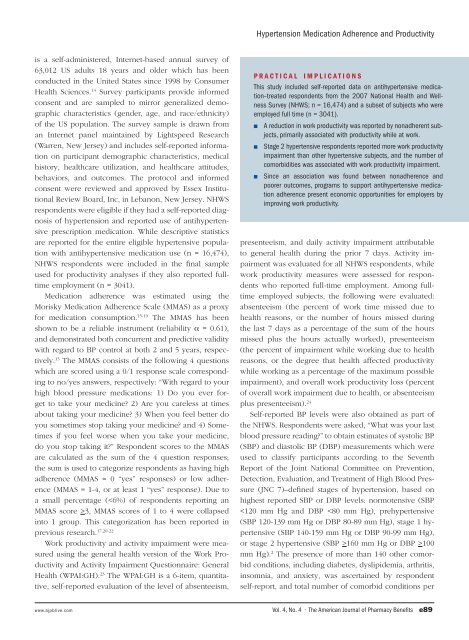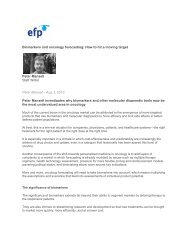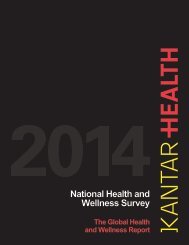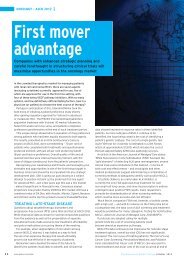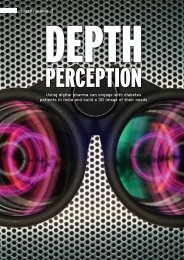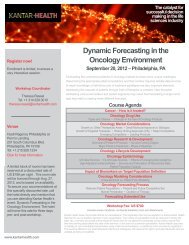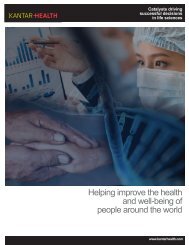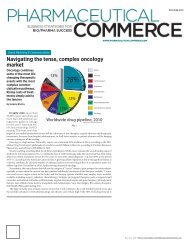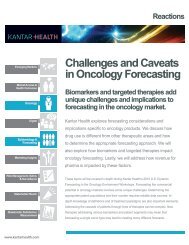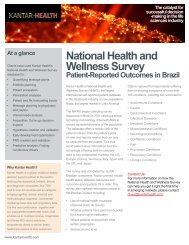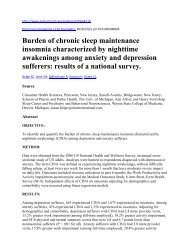Impact of Medication Adherence on Work ... - Kantar Health
Impact of Medication Adherence on Work ... - Kantar Health
Impact of Medication Adherence on Work ... - Kantar Health
You also want an ePaper? Increase the reach of your titles
YUMPU automatically turns print PDFs into web optimized ePapers that Google loves.
Hypertensi<strong>on</strong> <str<strong>on</strong>g>Medicati<strong>on</strong></str<strong>on</strong>g> <str<strong>on</strong>g>Adherence</str<strong>on</strong>g> and Productivity<br />
is a self-administered, Internet-based annual survey <str<strong>on</strong>g>of</str<strong>on</strong>g><br />
63,012 US adults 18 years and older which has been<br />
c<strong>on</strong>ducted in the United States since 1998 by C<strong>on</strong>sumer<br />
<strong>Health</strong> Sciences. 14 Survey participants provide informed<br />
c<strong>on</strong>sent and are sampled to mirror generalized demographic<br />
characteristics (gender, age, and race/ethnicity)<br />
<str<strong>on</strong>g>of</str<strong>on</strong>g> the US populati<strong>on</strong>. The survey sample is drawn from<br />
an Internet panel maintained by Lightspeed Research<br />
(Warren, New Jersey) and includes self-reported informati<strong>on</strong><br />
<strong>on</strong> participant demographic characteristics, medical<br />
history, healthcare utilizati<strong>on</strong>, and healthcare attitudes,<br />
behaviors, and outcomes. The protocol and informed<br />
c<strong>on</strong>sent were reviewed and approved by Essex Instituti<strong>on</strong>al<br />
Review Board, Inc, in Leban<strong>on</strong>, New Jersey. NHWS<br />
resp<strong>on</strong>dents were eligible if they had a self-reported diagnosis<br />
<str<strong>on</strong>g>of</str<strong>on</strong>g> hypertensi<strong>on</strong> and reported use <str<strong>on</strong>g>of</str<strong>on</strong>g> antihypertensive<br />
prescripti<strong>on</strong> medicati<strong>on</strong>. While descriptive statistics<br />
are reported for the entire eligible hypertensive populati<strong>on</strong><br />
with antihypertensive medicati<strong>on</strong> use (n = 16,474),<br />
NHWS resp<strong>on</strong>dents were included in the final sample<br />
used for productivity analyses if they also reported fulltime<br />
employment (n = 3041).<br />
<str<strong>on</strong>g>Medicati<strong>on</strong></str<strong>on</strong>g> adherence was estimated using the<br />
Morisky <str<strong>on</strong>g>Medicati<strong>on</strong></str<strong>on</strong>g> <str<strong>on</strong>g>Adherence</str<strong>on</strong>g> Scale (MMAS) as a proxy<br />
for medicati<strong>on</strong> c<strong>on</strong>sumpti<strong>on</strong>. 15-19 The MMAS has been<br />
shown to be a reliable instrument (reliability α = 0.61),<br />
and dem<strong>on</strong>strated both c<strong>on</strong>current and predictive validity<br />
with regard to BP c<strong>on</strong>trol at both 2 and 5 years, respectively.<br />
15 The MMAS c<strong>on</strong>sists <str<strong>on</strong>g>of</str<strong>on</strong>g> the following 4 questi<strong>on</strong>s<br />
which are scored using a 0/1 resp<strong>on</strong>se scale corresp<strong>on</strong>ding<br />
to no/yes answers, respectively: “With regard to your<br />
high blood pressure medicati<strong>on</strong>s: 1) Do you ever forget<br />
to take your medicine? 2) Are you careless at times<br />
about taking your medicine? 3) When you feel better do<br />
you sometimes stop taking your medicine? and 4) Sometimes<br />
if you feel worse when you take your medicine,<br />
do you stop taking it?” Resp<strong>on</strong>dent scores to the MMAS<br />
are calculated as the sum <str<strong>on</strong>g>of</str<strong>on</strong>g> the 4 questi<strong>on</strong> resp<strong>on</strong>ses;<br />
the sum is used to categorize resp<strong>on</strong>dents as having high<br />
adherence (MMAS = 0 “yes” resp<strong>on</strong>ses) or low adherence<br />
(MMAS = 1-4, or at least 1 “yes” resp<strong>on</strong>se). Due to<br />
a small percentage (3, MMAS scores <str<strong>on</strong>g>of</str<strong>on</strong>g> 1 to 4 were collapsed<br />
into 1 group. This categorizati<strong>on</strong> has been reported in<br />
previous research. 17,20-22<br />
<strong>Work</strong> productivity and activity impairment were measured<br />
using the general health versi<strong>on</strong> <str<strong>on</strong>g>of</str<strong>on</strong>g> the <strong>Work</strong> Productivity<br />
and Activity Impairment Questi<strong>on</strong>naire: General<br />
<strong>Health</strong> (WPAI:GH). 23 The WPAI:GH is a 6-item, quantitative,<br />
self-reported evaluati<strong>on</strong> <str<strong>on</strong>g>of</str<strong>on</strong>g> the level <str<strong>on</strong>g>of</str<strong>on</strong>g> absenteeism,<br />
PRACTICAL IMPLICATIONS<br />
This study included self-reported data <strong>on</strong> antihypertensive medicati<strong>on</strong>–treated<br />
resp<strong>on</strong>dents from the 2007 Nati<strong>on</strong>al <strong>Health</strong> and Wellness<br />
Survey (NHWS; n = 16,474) and a subset <str<strong>on</strong>g>of</str<strong>on</strong>g> subjects who were<br />
employed full time (n = 3041).<br />
n A reducti<strong>on</strong> in work productivity was reported by n<strong>on</strong>adherent subjects,<br />
primarily associated with productivity while at work.<br />
n Stage 2 hypertensive resp<strong>on</strong>dents reported more work productivity<br />
impairment than other hypertensive subjects, and the number <str<strong>on</strong>g>of</str<strong>on</strong>g><br />
comorbidities was associated with work productivity impairment.<br />
n Since an associati<strong>on</strong> was found between n<strong>on</strong>adherence and<br />
poorer outcomes, programs to support antihypertensive medicati<strong>on</strong><br />
adherence present ec<strong>on</strong>omic opportunities for employers by<br />
improving work productivity.<br />
presenteeism, and daily activity impairment attributable<br />
to general health during the prior 7 days. Activity impairment<br />
was evaluated for all NHWS resp<strong>on</strong>dents, while<br />
work productivity measures were assessed for resp<strong>on</strong>dents<br />
who reported full-time employment. Am<strong>on</strong>g fulltime<br />
employed subjects, the following were evaluated:<br />
absenteeism (the percent <str<strong>on</strong>g>of</str<strong>on</strong>g> work time missed due to<br />
health reas<strong>on</strong>s, or the number <str<strong>on</strong>g>of</str<strong>on</strong>g> hours missed during<br />
the last 7 days as a percentage <str<strong>on</strong>g>of</str<strong>on</strong>g> the sum <str<strong>on</strong>g>of</str<strong>on</strong>g> the hours<br />
missed plus the hours actually worked), presenteeism<br />
(the percent <str<strong>on</strong>g>of</str<strong>on</strong>g> impairment while working due to health<br />
reas<strong>on</strong>s, or the degree that health affected productivity<br />
while working as a percentage <str<strong>on</strong>g>of</str<strong>on</strong>g> the maximum possible<br />
impairment), and overall work productivity loss (percent<br />
<str<strong>on</strong>g>of</str<strong>on</strong>g> overall work impairment due to health, or absenteeism<br />
plus presenteeism). 24<br />
Self-reported BP levels were also obtained as part <str<strong>on</strong>g>of</str<strong>on</strong>g><br />
the NHWS. Resp<strong>on</strong>dents were asked, “What was your last<br />
blood pressure reading?” to obtain estimates <str<strong>on</strong>g>of</str<strong>on</strong>g> systolic BP<br />
(SBP) and diastolic BP (DBP) measurements which were<br />
used to classify participants according to the Seventh<br />
Report <str<strong>on</strong>g>of</str<strong>on</strong>g> the Joint Nati<strong>on</strong>al Committee <strong>on</strong> Preventi<strong>on</strong>,<br />
Detecti<strong>on</strong>, Evaluati<strong>on</strong>, and Treatment <str<strong>on</strong>g>of</str<strong>on</strong>g> High Blood Pressure<br />
(JNC 7)–defined stages <str<strong>on</strong>g>of</str<strong>on</strong>g> hypertensi<strong>on</strong>, based <strong>on</strong><br />
highest reported SBP or DBP levels: normotensive (SBP<br />
100<br />
mm Hg). 2 The presence <str<strong>on</strong>g>of</str<strong>on</strong>g> more than 140 other comorbid<br />
c<strong>on</strong>diti<strong>on</strong>s, including diabetes, dyslipidemia, arthritis,<br />
insomnia, and anxiety, was ascertained by resp<strong>on</strong>dent<br />
self-report, and total number <str<strong>on</strong>g>of</str<strong>on</strong>g> comorbid c<strong>on</strong>diti<strong>on</strong>s per<br />
www.ajpblive.com<br />
Vol. 4, No. 4 • The American Journal <str<strong>on</strong>g>of</str<strong>on</strong>g> Pharmacy Benefits e89


